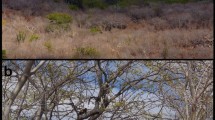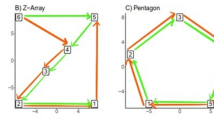Abstract
Many wild primates occupy large home ranges and travel long distances each day. Navigating these ranges to find sufficient food presents a substantial cognitive challenge, but we are still far from understanding either how primates represent spatial information mentally or how they use this information to navigate under natural conditions. In the course of a long-term socioecological study, we investigated and compared the travel paths of sympatric spider monkeys (Ateles belzebuth) and woolly monkeys (Lagothrix poeppigii) in Amazonian Ecuador. During several field seasons spanning an 8-year period, we followed focal individuals or groups of both species continuously for periods of multiple days and mapped their travel paths in detail. We found that both primates typically traveled through their home ranges following repeatedly used paths, or “routes”. Many of these routes were common to both species and were stable across study years. Several important routes appeared to be associated with distinct topographic features (e.g., ridgetops), which may constitute easily recognized landmarks useful for spatial navigation. The majority of all location records for both species fell along or near identified routes, as did most of the trees used for fruit feeding. Our results provide strong support for the idea that both woolly and spider monkey use route-based mental maps similar to those proposed by Poucet (Psychol Rev 100:163–182, 1993). We suggest that rather than remembering the specific locations of thousands of individual feeding trees and their phenological schedules, spider and woolly monkeys could nonetheless forage efficiently by committing to memory a series of route segments that, when followed, bring them into contact with many potential feeding sources for monitoring or visitation. Furthermore, because swallowed and defecated seeds are deposited in greater frequency along routes, the repeated use of particular travel paths over generations could profoundly influence the structure and composition of tropical forests, raising the intriguing possibility that these and other primate frugivores are active participants in constructing their own ecological niches. Building upon the insights of Byrne (Q J Exp Psychol 31:147–154, 1979, Normality and pathology in cognitive functions. Academic, London, pp 239–264, 1982) and Milton (The foraging strategy of howler monkeys: a study in primate economics. Columbia University Press, New York, 1980, On the move: how and why animals travel in groups. University of Chicago Press, Chicago, pp 375–417, 2000), our results highlight the likely general importance of route-based travel in the memory and foraging strategies of nonhuman primates.





Similar content being viewed by others
References
Barton RA (2000) Primate brain evolution: cognitive demands of foraging or social life. In: Boinski SB, Garber PA (eds) On the move: how and why animals travel in groups. University of Chicago Press, Chicago, pp 204–237
Benhamou S (1996) No evidence for cognitive mapping in rats. Anim Behav 52:201–212
Bennett ATD (1996) Do animals have cognitive maps? J Exp Biol 199:219–224
Boinski S, Garber PA (eds) (2000) On the move: how and why animals travel in groups. University of Chicago Press, Chicago
Byrne RW (1979) Memory for urban geography. Q J Exp Psychol 31:147–154
Byrne RW (1982). Geographical knowledge and orientation. In: Ellis A (ed) Normality and pathology in cognitive functions. Academic, London, pp 239–264
Byrne R (2000) How monkeys find their way: leadership, coordination, and cognitive maps of African baboons. In: Boinski SB, Garber PA (eds) On the move: how and why animals travel in groups. University of Chicago Press, Chicago, pp 491–518
Cant JGH, Youlatos D, Rose MD (2001) Locomotor behavior of Lagothrix lagothricha and Ateles belzebuth in Yasuní National Park, Ecuador: general patterns and nonsuspensory modes. J Hum Evolut 41:141–166
Chapman CA, Wrangham RW, Chapman LJ (1995) Ecological constraints on group size: an analysis of spider monkey and chimpanzee subgroups. Behav Ecol Sociobiol 36:59–70
Cunningham E, Janson C (2007) A socioecological perspective on primate cognition, past and present. Anim Cogn. doi:10.1007/s10071-007-0078-3
Defler TR (1996) Aspects of the ranging pattern in a group of wild woolly monkeys (Lagothrix lagothricha). Am J Primatol 38:289–302
Dew JL (2001) Synecology and seed dispersal in woolly monkeys (Lagothrix lagotricha peoppigii) and spider monkeys (Ateles belzebuth belzebuth) in Parque Nacional Yasuní, Ecuador. PhD Dissertation, Department of Anthropology, University of California
Di Fiore A (1997) Ecology and behavior of lowland woolly monkeys (Lagothrix lagotricha poeppigii, Atelinae) in Eastern Ecuador. PhD Dissertation, Department of Anthropology, University of California
Di Fiore A (2003) Ranging behavior and foraging ecology of lowland woolly monkeys (Lagothrix lagotricha poeppigii) in Yasuní National Park, Ecuador. Am J Primatol 59:47–66
Di Fiore A (2004) Diet and feeding ecology of woolly monkeys in a western Amazonian rainforest. Int J Primatol 24:767–801
Di Fiore A, Campbell CJ (2007) The atelines: Variation in ecology, behavior, and social organization. In: Campbell CJ, Fuentes A, MacKinnon KC, Panger M, Bearder S (eds) Primates in perspective. Oxford University Press, New York, pp 155–185
Etienne AS, Maurer R, Séguinot V (1996) Path integration in mammals and its interaction with visual landmarks. J Exp Biol 199:201–209
Gallistel CR (1989) Animal cognition: the representation of space, time and number. Ann Rev Psychol 40:155–189
Gallistel CR, Cramer AE (1996) Computations on metric maps in mammals: getting oriented and choosing a multi-destination route. J Exp Biol 199:211–217
Garber PA (1989) Role of spatial memory in primate foraging patterns: Saguinus mystax and Saguinus fuscicollis. Am J Primatol 19:203–216
Garber PA (2000) Evidence for the use of spatial, temporal, and social information by some primate foragers. In: Boinski SB, Garber PA (eds) On the move: how and why animals travel in groups. University of Chicago Press, Chicago, pp 261–298
Gould JL (1987) Landmark learning by honey bees. Anim Behav 35:26–34
Gould-Beierle K, Kamil A (1996) The use of local and global cues by Clark’s nutcrackers, Nucifraga columbiana. Anim Behav 52:519–528
Hitchcock C, Sherry D. (1990) Long-term memory for cache sites in the black-capped chickadee. Anim Behav 40:701–712
Jacobs L, Liman E (1991) Grey squirrels remember the locations of buried nuts. Anim Behav 41:103–110
Janson CH (1998) Experimental evidence for spatial memory in foraging wild capuchin monkeys, Cebus apella. Anim Behav 55:1229–1243
Janson C (2000) Spatial movement strategies: theory, evidence, and challenges. In: Boinski SB, Garber PA (eds) On the move: how and why animals travel in groups. University of Chicago Press, Chicago, pp 165–203
Janson C (2007) Experimental evidence for route integration and strategic planning in wild capuchin monkeys. Anim Cogn. doi:10.1007/s10071-007-0079-2
Janson CH, Di Bitetti MS (1997) Experimental analysis of food detection in cauchin monkeys: effects of distance, travel speed, and resource size. Behav Ecol Sociobiol 41:17–24
Jones CG, Lawton JH, Shachak M (1994) Organisms as ecosystem engineers. Oikos 69:373–386
Klein LL, Klein DJ (1977) Feeding behavior of the Colombian spider monkey, Ateles belzebuth. In: Clutton-Brock TH (ed) Primate ecology: studies of feeding and ranging behaviour in lemurs, monkeys, and apes. Academic, London, pp 153–181
Laland KN, Odling-Smee FJ, Feldman MW (1999) Evolutionary consequences of niche construction and their implications for ecology. Proc Natl Acad Sci USA 96:10242–10247
MacKinnon JR (1974) The behavior and ecology of wild orang-utans (Pongo pygmaeus). Anim Behav 22:3–74
Menzel CR (1991) Cognitive aspects of foraging in Japanese monkeys. Anim Behav 41:397–402
Milton K (1980) The foraging strategy of howler monkeys: a study in primate economics. Columbia University Press, New York
Milton K (1981) Diversity of plant foods in tropical forests as a stimulus to mental development in primates. Am Anthropol 83:534–548
Milton K (2000) Quo vadis? Tactics of food search and group movement in primates and other animals. In: Boinski SB, Garber PA (eds) On the move: how and why animals travel in groups. University of Chicago Press, Chicago, pp 375–417
Odling-Smee FJ (1988) Niche constructing phenotypes. In: Plotkin HC (ed) The role of behavior in evolution. MIT Press, Cambridge, pp 73–132
Odling-Smee FJ, Laland KN, Feldman MW (1996) Niche construction. Am Nat 147:641–648
Odling-Smee FJ, Laland NK, Feldman MW (2003) Niche construction: the neglected process in evolution. Princeton University Press, Princeton
O’Keefe J, Nadel L (1978) The hippocampus as a cognitive map. Oxford University Press, Oxford
Peres CA (1994) Diet and feeding ecology of gray woolly monkeys (Lagothrix lagotricha cana) in Central Amazonia: comparisons with other atelines. Int J Primatol 15:333–372
Poucet B (1993) Spatial cognitive maps in animals: new hypotheses on their structure and neural mechanisms. Psychol Rev 100:163–182
Russo SE (2003) Linking spatial patterns of seed dispersal and plant recruitment in a neotropical tree, Virola calophylla (Myristicaceae). PhD Dissertation, Department of Biology, University of Illinois, Urbana-Champaign
Sigg H, Stolba A (1981) Home range and daily march in a hamadryas baboon troop. Folia Primatol 36:40–75
Stevenson PR (2000) Seed dispersal by woolly monkeys (Lagothrix lagothricha) at Tinigua National Park, Colombia: dispersal distance, germination rates, and dispersal quantity. Am J Primatol 50:275–289
Stevenson PR, Castellanos MC, Pizarro JC, Garavito M (2002) Effects of seed dispersal by three ateline monkey species on seed germination at Tinigua National Park, Colombia. Int J Primatol 23:1187–1204
Stevenson PR, Quiñones MJ, Ahumada JA (1994) Ecological strategies of woolly monkeys (Lagothrix lagotricha) at Tinigua National Park, Colombia. Am J Primatol 32:123–140
Suarez SA (2003) Spatio-temporal foraging skills of white-bellied spider monkeys (Ateles belzebuth belzebuth) in the Yasuni National Park, Ecuador. PhD Dissertation, State University of New York at Stony Brook, Stony Brook
Suarez SA (2006) Diet and travel costs for spider monkeys in a nonseasonal, hyperdiverse environment. Int J Primatol 27:411–436
Symington MM (1990) Fission-fusion social organization in Ateles and Pan. Int J Primatol 11:47–61
Tolman EC (1948) Cognitive maps in rats and men. Psychol Rev 55:189–208
van Roosmalen MGM (1985) Habitat preferences, diet, feeding strategy and social organization of the black spider monkey (Ateles paniscus paniscus Linnaeus 1758) in Surinam. Acta Amazonica 15:1–238
Vlasak AN (2006a) Global and local spatial landmarks: their role during foraging by Columbian ground squirrels (Spermophilus columbianus). Anim Cogn 9:71–80, doi:10.1007/s10071-005-0006-3
Vlasak AN (2006b) The relative importance of global and local landmarks in navigation by Columbian ground squirrels (Spermophilus columbianus). J Comp Psychol 120:131–138
Yumoto T, Kimura K, Nishimura A (1999) Estimation of the retention times and distances of seed dispersed by two monkey species, Alouatta seniculus and Lagothrix lagotricha, in a Colombian forest. Ecol Res 14:179–191
Wrangham RW (1977) Feeding behaviour of chimpanzees in Gombe National Park, Tanzania. In: Clutton-Brock TH (ed) Primate ecology: studies of feeding and ranging behaviour in lemurs, monkeys, and apes. Academic, London, pp 504–538
Acknowledgments
We are very grateful to the Ministerio del Ambiente of the government of Ecuador for their continued interest in long-term research on the primate community of Yasuní National Park. Logistical support for this study was provided by the Estación Científica Yasuní of the Pontificia Universidad Católica del Ecuador. We are also grateful to Maxus Ecuador, Inc. and Repsol-YPF for additional assistance. Numerous field assistants and companions helped with the collection of primate ranging data and with trail mapping, including Wampi Ahua, Larry Dew, Nathaniel Gerhardt, Carrie Linder, Christine Lucas, Juan Nenquimo, Boyo Orengo, Kristin Phillips, Wilmer Pozo, Stephanie Spehar, Matt Swarner, Julia Willner, Denis Youlatos, and, especially, Andres Link who collected much of the 2002–2003 data. Financial support was provided by the NSF, the Wenner-Gren Foundation for Anthropological Research, the L.S.B. Leakey Foundation, Primate Conservation, Inc., the University of California at Davis, New York University, Stony Brook University, and the New York Consortium in Evolutionary Primatology. Finally, we thank Elena Cunningham and Charlie Janson for inviting us to participate in the “Socioecological Cognition” symposium held at the XXth Congress of the International Primatological Society in Torino, Italy, and we are grateful to Sue Boinski and three anonymous reviewers whose comments contributed to the improvement of this manuscript.
Author information
Authors and Affiliations
Corresponding author
Additional information
This contribution is part of the Special Issue “A Socioecological Perspective on Primate Cognition” (Cunningham and Janson 2007).
Rights and permissions
About this article
Cite this article
Di Fiore, A., Suarez, S.A. Route-based travel and shared routes in sympatric spider and woolly monkeys: cognitive and evolutionary implications. Anim Cogn 10, 317–329 (2007). https://doi.org/10.1007/s10071-006-0067-y
Received:
Revised:
Accepted:
Published:
Issue Date:
DOI: https://doi.org/10.1007/s10071-006-0067-y




